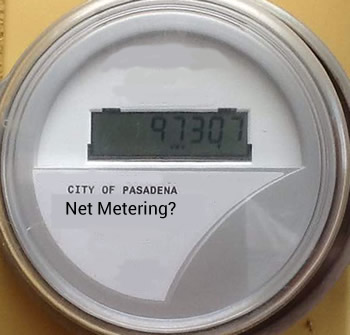Welcome to the
Run on Sun Monthly Newsletter

In this Issue: |
April, 2016
Volume: 7 Issue: 4
SunEdison's Failure - Non-Event for Our Solar ClientsSecond only to the flame-out of oft-maligned Solyndra, the bankruptcy filing this month of once high-flying SunEdison has gotten a great deal of press, particularly by those who follow the financial side of the solar industry closely. But what does it really mean for residential, non-profit, and small commercial solar clients? In a word - nothing, and here's why. BackgroundSunEdison, is a developer of utility-scale solar projects, that is, projects that sell energy directly to a utility rather than offsetting the energy loads of a local customer.
In recent years SunEdison expanded aggressively, creating two captive subsidiaries known as yieldcos to purchase the parent's projects at a premium, sell the energy and pay investors dividends from those projects - thereby enticing more investors, which provided more capital to purchase more projects, thus paying more dividends and on, and on. Until it didn't. Possibly the straw that broke the investors' back, however, was the deal that SunEdison announced last July to purchase Vivint Solar at a 52% premium. To a lot of folks this seemed like an odd move - Vivint is a major player in the residential solar space where it competes against SolarCity (and us!) - not a real fit with a developer of mostly utility scale projects. That deal spooked investors, liquidity became an issue, and the Vivint deal dissolved into litigation in March. BankruptWith the demise of the Vivint deal, rumors of bankruptcy grew, culminating in its filing for Chapter 11 reorganization on April 21. The announcement - ironically one week after coal giant Peabody Energy did the same thing - generated some pretty scathing coverage:
While certainly not the level of vitriol directed at the failure of Solyndra, those are still tough headlines (and interesting articles, should you be inclined to dive deeper). Meanwhile, back on your roof...So while there is a great deal of buzz about the problems facing SunEdison, they really have nothing to do with the markets that our clients occupy. We, along with the other local, independent solar installers out there, are still doing just fine, thank you! We have never purchased products from SunEdison, so none of our product warranties are affected. In the end, this story does highlight one consideration for potential clients to consider as you mull over the trade-offs between a smaller, local company and a large, national chain. If even the biggest firm can fail, as SunEdison has shown, so can the other giants out there. So if there is no guarantee that either the large or the small company will still be around in ten years, where would you rather place your bet: with the small company that takes the time to get the job done right, or with the giant that is bragging to its investors how it takes a day or less to install a system? At the end of the day, size may matter, just not in the way you would originally think! |
“So while there is a great deal of buzz about the problems facing SunEdison, they really have nothing to do with the markets that our clients occupy…”
Get your copy of
Commercial Solar:
Step-by-Step
from
Run on Sun
Founder & CEO
Jim Jenal

Now available on Amazon.com
in both
Print & Kindle versions.
Bonus - Buy the Print version…
Get the
Kindle version for Free!
Commercial Solar:
Step-by-Step
from Run on Sun
Founder & CEO
Jim Jenal

Now available on Amazon.com
in both Print & Kindle versions.
Get the Kindle version for Free!
Help Us Spread the News!


We use Angie's List to assess whether we're doing a good job keeping valued clients happy. Please visit AngiesList.com in order to grade our quality of work and client service.
Solar Impulse - Triumphant in CA!Longtime readers of this newsletter will know that we have been following the progress of the Solar Impulse team for many years. Headed by adventurers/pilots Bertrand Piccard and André Borschberg, the Solar Impulse project was about building an airplane that could fly around the world powered only by solar power! The original craft, Solar Impulse 1, flew across the United States back in 2013 as a proof-of-concept design that could set the stage for the around-the-world attempt. That audacious enterprise begin in March of 2015 as Solar Impulse 2 launched from Abu Dhabi on its way around the world. Last summer, SI2 made it to Hawaii, but the effort needed for that extended non-stop flight from Japan damaged the batteries and required some redesign and retrofitting before the mission could proceed. But this Thursday, April 21, was finally the day, and SI2 departed from Hawaii, headed for a landing at Moffet Airfield outside of San Francisco - a 62 hour flight! For those who haven't been following the mission, since there is only one pilot on-board, he can never really sleep during the flight. Instead he takes power naps of 20 minutes at a time, assisted by self-hypnosis to quickly bring about a state of relaxation. In addition, the pilot does yoga and the limited exercises afforded by his incredibly small and cramped cabin. Ah to have been in the San Francisco Bay area that evening! What a beautiful and inspiring sight! The Solar Impulse team still has a great deal of work ahead of them including crossing the United States (they will be flying into New York City which should be something!) before crossing the Atlantic as they complete their mission of showing the world the true capability of clean energy. |
Munis Shutting Down Net Metering!
How We Got HereThe munis are generally free, within the limits of state law, to set their own policies as confirmed by the local city council. So here in Pasadena, PWP sets its policy but has to have that policy ratified by the city council's vote. When it comes to Net Metering, state law requires that the munis, like the IOUs, offer Net Metering agreements until the amount of solar deployed exceeds "5% of the electric utility's aggregate customer peak demand." (CA Public Utilities Code § 2827) Now if that quote seems like less than a model of clarity, you are quite right. Before the CPUC, the IOUs argued that it meant that you look at a utility's highest peak demand as of a certain point in time, and that would be the cap. Such an interpretation, however, reads the words "aggregate customer" out of the statute. The CPUC agreed, and the proper interpretation requires the utility to sum the aggregate demand from each customer and that becomes the cap. The results are dramatic - the proper interpretation effectively doubles the total amount of solar allowed under the cap. That decision by the CPUC back in 2012 redefined Net Metering, but only for the IOUs. At the time there was little concern regarding the munis since none was close to reaching their cap. Fast forward to today and five munis have already reached their caps, as calculated under the old, pre-CPUC ruling, methodology. That leaves them free to replace Net Metering with whatever they choose, and at least one, Turlock, has adopted new rules that have resulted in an 85% decline in the solar market there! (In contrast, LADWP has already agreed to the new methodology thanks to leadership from Mayor Garcetti.) Support AB 2339!Fortunately there is a fix in the works. AB 2339 (Irwin - D-44) will require that the munis calculate their caps in effectively the same way as the IOUs. There is a website where anyone can go to express their support for expanding the benefits of Net Metering to muni customers throughout the State. Just click on the button to make this happen: Sadly, the list of entities opposing this bill includes Pasadena Water and Power - looks like we need some political leadership here in our own backyard to get PWP on board. |




